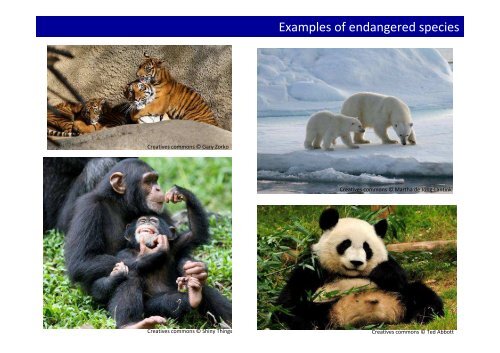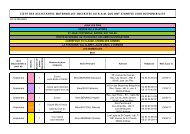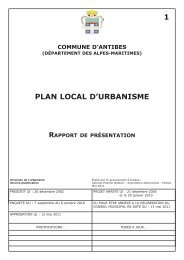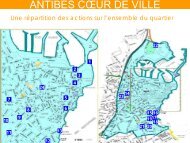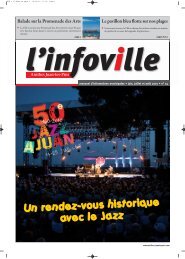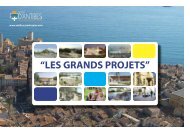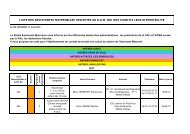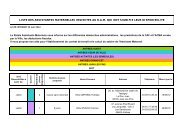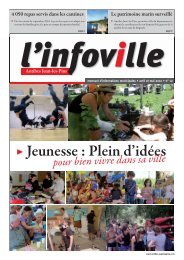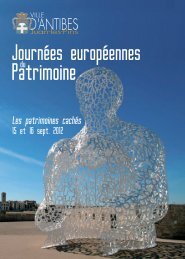Diaporama de l'opérateur (pdf) - Antibes Juan-les-Pins
Diaporama de l'opérateur (pdf) - Antibes Juan-les-Pins
Diaporama de l'opérateur (pdf) - Antibes Juan-les-Pins
You also want an ePaper? Increase the reach of your titles
YUMPU automatically turns print PDFs into web optimized ePapers that Google loves.
Examp<strong>les</strong> of endangered speciesCreatives commons © Gary ZorkoCreatives commons © Martha <strong>de</strong> Jong-LantinkCreatives commons © Shiny ThingsCreatives commons © Ted Abbott
Natura 2000: aEuropean networkhttp://natura2000.eea.europa.eu
Natura 2000 : a european network• La démarche Natura 2000 est fondée sur 2 directives européennes : ladirective « Habitat » et la directive « Oiseaux »• Natura 2000 a pour objectif <strong>de</strong> préserver la biodiversité et en particulier, enmer : <strong>les</strong> herbiers <strong>de</strong> posidonies et <strong>les</strong> coraux, par exemple.Les posidonies et <strong>les</strong> coraux sont même <strong>de</strong>s écosystèmes menacés, à préserver,ils abritent <strong>de</strong> nombreux autres animaux et végétaux qui ne peuvent passurvivre ailleurs.• Natura 2000 is based on 2 european directives : birds directive and habitatdirective• The aim is the conservation of biodiversity, and in particular marinebiodiversity : posidonia and coral reefs for example.Posidonia and coral reefs aren’t only endangered species. They are endangere<strong>de</strong>cosystems too. They shelter a lot of animals and plant life which can’t liveanywhere else.
« Baie et Cap d’<strong>Antibes</strong> – I<strong>les</strong> <strong>de</strong> Lérins » area – Natura 2000• Un site Natura 2000 présente un patrimoine naturel d’une exceptionnellerichesse et d’une très gran<strong>de</strong> valeur, c’est le cas <strong>de</strong> ce site.• Les zones <strong>de</strong> mouillage du Golfe <strong>Juan</strong> font partie du site Natura 2000• A Natura 2000 area is an area with an exceptional ecosystem and veryimportant natural ressources. « Baie et Cap d’<strong>Antibes</strong> – I<strong>les</strong> <strong>de</strong> Lérins » area isone of Natura 2000’s areas.• Golfe <strong>Juan</strong> mooring areas belong to this Natura 2000 area
Posidonia© JL FERRETTI
Posidonia• l’écosystème-pivot <strong>de</strong> la Méditerranée : on y rencontre 20 à 25 % <strong>de</strong>s espècesanima<strong>les</strong> et végéta<strong>les</strong> connues <strong>de</strong> la MéditerranéePROTEGER <strong>les</strong> posidonies = PROTEGER ¼ <strong>de</strong>s êtres-vivants connus <strong>de</strong> la Méditerranée• Quels sont, d’après vous, <strong>les</strong> rô<strong>les</strong> que jouent <strong>les</strong> posidonies ?• This is the key ecosystem of the Mediterranean. 20 to 25% of animal and plantlife species are found in PosidoniaPROTECTING Posidonia is equal to PROTECTING ¼ of living species known in theMediterranean• In your opinion, what are the functions of posidonia ?
ROLES :-Production d’oxygène (c’est une plante, comme sur terre, et pas une algue)équivaut aux forêts sur terre : poumons <strong>de</strong> la MéditerranéePlus <strong>de</strong> posidonies = plus <strong>de</strong> production d’oxygène-Séquestration du CO2 car plante chlorophyllienne = photosynthèse comme <strong>les</strong>forêts aussiROLES : Plus <strong>de</strong> posidonies = augmentation du CO2 dans l’atmosphère-Oxygen production (This is a plant, like on land, and not seaweed) We canconsi<strong>de</strong>r them as marine forests, the lungs of the MediterraneanNo more posidonia = no more oxygen production-Capturing CO2 It’s a chlorophyllian plant so it photosynthesizes (like foreststoo) No more posidonia = Increasing of CO2 in the atmospherePosidonia
-Captage <strong>de</strong>s sédiments par ses feuil<strong>les</strong> et ses rhizomes : participe à la clarté <strong>de</strong>l’eau Plus <strong>de</strong> posidonies = eau <strong>de</strong> baigna<strong>de</strong> plus troublePosidonia-Stabilisation <strong>de</strong>s fonds marins avec ses rhizomes (racines souterraines)Plus <strong>de</strong> posidonies = fonds marins moins stab<strong>les</strong>-Capturing sediment with its leaves and rootstocks. It takes part in improvingthe clarity of water. No more posidonia = cloudier and dirtier swimming water-Stabilization of seabeds with its rhizomes (rootstocks) No more posidonia = <strong>les</strong>s stable seabeds
-Zone d’abri, <strong>de</strong> reproduction, <strong>de</strong> frayère pour <strong>de</strong> nombreuses espècesPosidonia Plus <strong>de</strong> posidonies = disparition <strong>de</strong> toutes <strong>les</strong> espèces vivants dans<strong>les</strong> posidonies (poissons, crustacés)-Protection <strong>de</strong>s plages<strong>les</strong> herbiers <strong>de</strong> posidonies amortissent <strong>les</strong> hou<strong>les</strong> : limitation <strong>de</strong> l’érosion<strong>les</strong> banquettes <strong>de</strong> posidonies (feuil<strong>les</strong> mortes sur <strong>les</strong> plages l’hiver) freinent laperte <strong>de</strong> sable lors <strong>de</strong>s coups <strong>de</strong> mer Plus <strong>de</strong> posidonies = diminution <strong>de</strong>s plages-Shelter, reproduction, spawning ground area for a lot of species No more posidonia = extinction of all the species living in posidonia(fish, shellfish, etc.)-Protection of beachesposidonia cushion the swell and surge, so limit erosionnatural banks of <strong>de</strong>ad posidonia (<strong>de</strong>ad leaves on beaches during winter) slowdown sand loss during winter storms No more posidonia = <strong>de</strong>creasing beaches
Scientific studies with experts in OceanologyPosidonia is endangeredDocuments <strong>de</strong> travailhectaresandhectares of<strong>de</strong>stroyedposidonia2007Andromè<strong>de</strong> OcéanologieContrat <strong>de</strong> baie2011Andromè<strong>de</strong> OcéanologieNatura 2000
Posidonia is endangered Posidonia• Dégradation dans la partie Est du Golfe <strong>Juan</strong> due essentiellement auxmouillages <strong>de</strong>s gran<strong>de</strong>s unités et aux ancres raguant <strong>les</strong> fonds marins.• La posidonie a une croissance très lente :1 cm par an ou tous <strong>les</strong> 10 ans selon <strong>les</strong> cas !• Toute dégradation est considérée comme irréversible par <strong>les</strong> scientifiques.• East of Golfe <strong>Juan</strong> damage are mainly caused by the mooring of yachts.This is caused by the anchors dragging along the seabed.• Posidonia <strong>de</strong>velops very slowly :1 cm by year or by 10 years <strong>de</strong>pending on cases !• Damage are consi<strong>de</strong>red as non-reversible by scientists.
Solutions• Immediate solutions : target clear areas to anchor (i.e. sand) lift the anchor straight up (rather than dragging) use environmentally-friendly anchors• Further i<strong>de</strong>as being consi<strong>de</strong>red : fixed anchors forbidding mooring in certain areas regulated mooring areas compulsory steering areas
Solutions• Dès maintenant : viser <strong>les</strong> zones claires (zones sableuses) pour mouiller remonter l’ancre à l’aplomb du bateau (plutôt que <strong>de</strong>racler <strong>les</strong> fonds avec l’ancre) utiliser <strong>de</strong>s ancres écologiques• Solutions en cours <strong>de</strong> réflexion : ancrages fixes zones d’interdiction <strong>de</strong> mouillage zones <strong>de</strong> mouillage réglementé zones <strong>de</strong> pilotage obligatoire
Thank you for your attentionCONTACTKaren Joyaux, chargée e <strong>de</strong> mission Natura 2000karen.joyaux@ville-antibes.fr04 92 90 67 42Plus d’infos d: www.antibes-juan<strong>les</strong>pins.com/natura-2000Service Mer et LittoralVille d’<strong>Antibes</strong> d<strong>Juan</strong>-<strong>les</strong><strong>les</strong>-<strong>Pins</strong><strong>Antibes</strong> Yacht ShowSaturday, April 14th 2012, <strong>Antibes</strong>UNION EUROPÉENNEFONDS EUROPÉEN AGRICOLEPOUR LE DÉVELOPPEMENT RURAL


